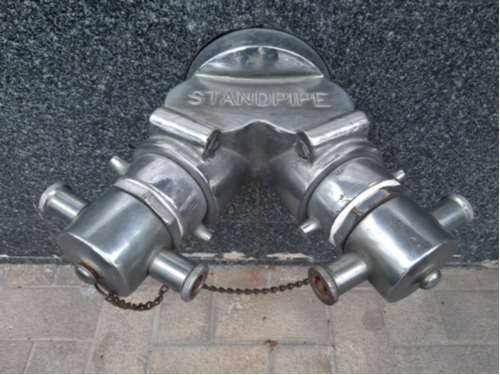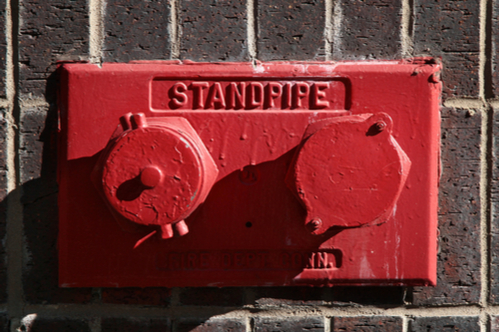standpipe design service
Our standpipe systems function optimally for maximum resiliency.
Materials, products, installation, maintenance- we never compromise on quality
We are trusted by countless businesses and families for our exception service.

With the great technological revolution, emerged the existence of high rise buildings. With the advent of modern skyscrapers, came new safety challenges as well. Fire is one of the most common and dangerous hazards that often put high rise buildings in risk.
Fires can not only cause property damage but also lead to loss of lives. It can destruct businesses, families and put your clients in danger.
According to NFPA, a home fire occurs every 88 seconds and structure fires occur every 63 seconds. In 2017, there were 499,000 structure fires which caused property loss of $10,700 million.
Surely you don't want anything like that to happen to your business or family. That's why buildings are mandated to have fire protection systems to prevent mishaps from turning into disasters.
Among fire protection systems, standpipes have a crucial role in enabling firefighters to douse flames and help them in their rescue operations.
Standpipes was a groundbreaking discovery to combat fires where firefighters cannot reach, especially the fires on the upper floors. New York Engineers designs complete fire protection systems with special emphasis on standpipes to equip your building for safety.
Our standpipe solutions go a long way in creating a resilient structure where fires if they happen, can be mitigated on time to avoid loss of lives and properties.

According to the National Fire Protection Association, who formed the basis of NFPA 14 (Standard for the Installation of Standpipe and Hose Systems) standpipes are supposed to be the equipment associated with the network of valves, piping, hose connections, and related parts.
All these are placed in such a way that the discharge of water in spray patterns or streams through the nozzles and hoses that are attached is possible. This complex structure is used to put out a fire. Which means, it is capable of protecting the people present inside the building, and also the structure of the building.
Basically, a standpipe is a vertical hose that is used to direct high-pressure water to the pump from a hose. It also often leads to a sprinkler system.
They are designed to assist the firefighters by strategically sending the water to water outlets that are strategically placed in different parts of the building.
We help you determine the best placement for standpipes so that firefighters can get quick access to your systems and put out the flames in time.
Standpipes are divided into three different categories, based on who is to monitor the water outlet in case of a fire. We design and install all classifications of standpipes based on your needs and circumstances.
In this case, firefighters must bring a hose to attach to these connections.
However, concerns are there about the safety of these hoses as the accessibility of these hoses is likely to be dangerous to any unskilled person that tries to use them. So they have gone out of use, and we don't use them for the older buildings.
A wet standpipe system does not require firefighters to supply water to them, as they already have pressurized water placed inside them. So, as soon as the hose is opened, water immediately flows out in high pressure. That is why they are also called automatic wet standpipe systems.
They are practical in those buildings which are high enough to make it impossible for the firefighters to supply water to high floors due to lack of pressure. However, they are impractical in the cases where the temperature is cold enough to freeze the water and damage the pipes.
These are almost the same as wet standpipe systems. However, they are more suited to the places that have a temperature at which water can freeze. However, instead of pressurized water, they have pressurized air inside them.
As soon as the valve is opened, the pressurized air is released, and it trips the systems to cause the water to flow. Permanent fire pumps are required by this system to deliver enough pressure at all times.
This kind of standpipe systems have the same kind of pressurized air as that of the dry standpipe systems, but water is present in the lesser piping. To activate the system, firefighters send a signal to the alarm panel after connecting the hose, which allows the water to flow.
These can only be used in places where water will not freeze in the pipes, as the water is present inside the hoses at all times. One advantage of this kind of piping is that it is cost effective. And the second advantage is that it is easier to spot a leak as soon as it happens, and it doesn’t hinder with the process in case of an emergency.
They work similarly to the wet systems. However, the water does not have enough pressure to be able to flow as soon as the hose is opened; someone from the fire department must be there to use a pumper. The pumper forces water from an external water supply into the pipes.
Last, comes the manual dry standpipe system. The reason it has been pushed to the last is because of its limitations.
Even though it is less expensive and can work in all environments, but there is no water or air present in the pipes. That makes it impossible to spot any leaks due to damage or corrosion before the emergency.
The department has to arrive and supply water or air through the pipes. Due to their drawbacks manual dry standpipes, we don't use in the buildings anymore.
We can help you determine the best type of standpipe to install in your building after careful consideration of several important factors. You can be sure that the system we choose will be the most effective for your individual needs.
Tests need to be performed to check the performance of standpipes. These maintenance testing have been defined in NPFA 25 as the general standards that are there to inspect, test, and maintain the fire protection systems that are based on water ejection.
We undertake comprehensive standpipe testing and inspection to ensure your systems are functional and up to the mark.
Here is an overview of the different test we conduct :
Waterflow alarms are of three kinds. We design them in such a way that they alert the bystanders and the building personnel if a fire protection system has been activated.
The paddle moves when the water starts to flow through the pipe, and in turn flips a switch. The switch triggers an electrical alarm. To be on the safe side and to avoid any false alarms, the alarm can be set on the delay of any preferred amount of time.
The method we use mainly depends on if the pipes are dry or wet. Or, what kind of temperature does the building have and if it is okay to allow the flow of water and not let it freeze.
However, they all work on the same principle, the connection of water flow to an outlet to see if it triggers an alarm.
The main drain of a standpipe is a drain that runs downstream from the water supply and the main control valve. If you close the main control valve first and then open the main drain, the system will be completely drained.
This will allow us to maintain or repair the main drain. According to NFPA 25, the main drain must be tested on a quarterly or annual basis. This is done to make sure all the blockages or any partially closed valves have been checked till the main drain. We also check the water pressure to make sure it is steady.
The gauges are supposed to be checked monthly, or quarterly. But apart from that, they must also be replaced after every five years. And the gauges that deflect more than 3% of the complete scale must be replaced or recalibrated.
Full scale means the maximum reading. The gauges are of relatively low prices, so replacing them is the best option.
According to the NFPA 25, all supervisory signals must be tested annually, except for the valve supervisory switches. The NFPA 72 states that a supervisory signal initiating device is a device that initiates, for example, a supervisory switch, low air pressure switch, or a water level indicator.
It is placed on the sprinkler system of dry pipes. If there occurs a change in signals, it will indicate a condition that isn’t normal.
Every control valve is supposed to be given a full round of motion at least once every year. This indicates that a valve that stays open is to be fully closed first and then opened again. It should be conducted along with a drain test, so it is a good idea to coordinate both of them.
These are to be conducted on automatic standpipe systems every five years. The purpose of this test is to ensure that the pressure at even the most remote hose connection is achievable when the standpipe is working on the demand of the system.
The pressure in class one and three systems needs to be 500 gpm. And the class two system must achieve a flow of 100 gpm. The flow meter is used to measure these values.
The values are measured by placing the flow meter at the hose outlets, and the individual gauges or the difference between the pressure of both can also be used to interpret this.
These tests are to be conducted every five years or annually. The tests are meant for relief valves or pressure reducing valves, particularly located at either hose rack assemblies, or hose connections.
The hose connections are present in class one and class three systems, and hose rack assemblies are present in class two, and sometimes class three systems.
You are supposed to conduct a full flow test every five years. We do this by taking the readings of the pressure of upstream as well as downstream of every single existing valve. This is to be done when the highest flow of water is flowing through the pipe.
The job of backflow preventer is to prevent the re-entering of stagnant water into the city water supply. It is more like maintenance than testing. We check the valves with the backflow preventer to make sure they are not stuck in a closed position.
To conduct the test, we open a connection that is downstream of the backflow preventer. This creates a system demand flow.
The piping from the fire department check valve to the fire department connection requires hydrostatic testing. To be specific, every piping in manual wet, semi-automatic dry and standpipe systems is to be tested after every five years.
However, the only case in which this test can be avoided is when the manual wet system is combined with sprinklers.
New York Engineers is a leader in designing highly efficient fire protection and fire fighting systems. We can design, install and test different types of standpipes and ensure their smooth functioning.
Our team assesses your building and construction drawings to find out the ideal placement of standpipes so that firefighters don't have to fumble around in case of emergencies.
Our standpipe systems provide a ready supply of water to mitigate fires and safeguard your property and lives. You can ensure the safety of your investment, property, employees, clients and family by working with our experienced engineers and architects. We offer highly professional service tailored to the specific needs of our clients.
Get in touch with us to discuss the safety arrangement of your building.